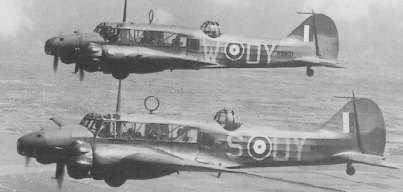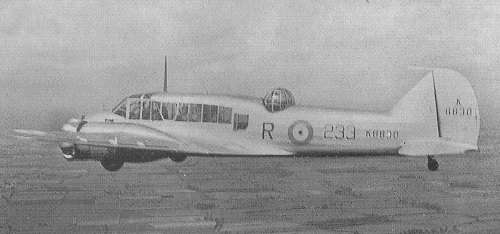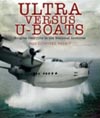
Two camouflaged Avro Ansons Mk.Is
The Avro Anson earned its nickname of "Faithful Annie" by serving the RAF from 1934 to 1968. To meet the G.18/35 requirement for Coastal Command, a design team lead by Roy Chadwick adapted the Avro 652. This had been designed for Imperial Airways, as a small four-seat transport and mail aircraft. The modified aircraft was the 652A, easily recognizable because it had large square windows instead of smaller oval ones, and was fitted with a dorsal gun turret. In 1936 the type entered service with No.48 Squadron, Coastal Command, as the Anson Mk.I. Until the Hudson replaced it, Coastal Command used the Anson for maritime reconnaissance and search & rescue. However, many of the 6742 Anson Mk.Is built were used as trainers. The Anson became the standard twin-engined trainer, and its original role was forgotten. 11020 were built, in a large number of versions, but only the Mk.I was used for maritime patrol.
The Anson Mk.I was a low-wing monoplane with retractable landing gear, a first for the RAF --- in fact so new that crews all too often forgot to perform the necessary task of turning a crank 160 times to wind down the landing gear. Of course there was a warning horn, but this was so irritating that many pilots disconnected it! Another concession to modern times was a blind flying panel. The construction, on the other hand, was thoroughly conventional: the wing was made of spruce and bakelite-bonded plywood, and its fuselage of steel tube with fabric and plywood covering. Originally the Ansons were painted with a shiny aluminium dope, but after the outbreak of war camouflage paint was applied. The cockpit with its large windows gave a good view all around. The engines were Armstrong Siddeley Cheetah IX radials, with two-bladed metal propellers. They were sufficient, but only just: If one engine failed the chances of staying in the air on the other one were slim.

A single Anson Mk.I in its pre-war silver dope colours.
The Anson had a crew of four: pilot, bomb aimer, gunner, wireless operator. The General Reconnaissance version had a manually-operated gun turret with a single .303 gun, and a fixed gun in the nose. The air gunners were volunteers drawn from the groundcrew, who received an additional shilling a day to their pay. Two 100lb bombs could be stowed internally, and external racks could carry eight 20lb bombs, flares or smoke generators.
The Anson was sturdy, reliable and pleasant to fly, and it was well-liked by its crews. It was a great success as a trainer. But as maritime reconnaissance aircraft it was a failure: Slow, vulnerable, short-ranged, with pitifully weak armament. The ineffectiveness of the 100lb bomb was illustrated in December 1939, when the British submarine HMS Snapper was attacked in error, hit directly, and suffered four broken lightbulbs. That Ansons were the mainstay of Coastal Command in 1939 illustrates the weakness of this service. Their replacement by Hudsons was a major step forward.
Avro Anson Mk.I
Two 320hp Armstrong Siddeley Cheetah IX engines
| Wing span | 17.22m |
| Length | 12.8m |
| Normal loaded weight | 3476kg, max weight 3627kg |
| Max Speed | 272 km |
| Range | 1062 km |


